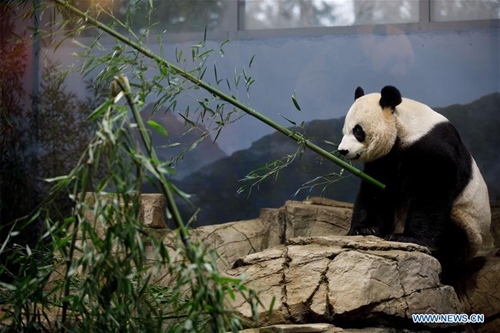China's panda research center responds to 'abusive treatment' claims of US-based giant panda
By Ji Yuqiao Source: Global Times Published: 2020/9/4 13:23:46

Giant Panda Mei Xiang eats treats in the giant panda house at the Smithsonian's National Zoo in Washington D.C., the United States, on Feb. 23, 2019. The Smithsonian's National Zoo in Washington D.C. held a housewarming event inside the giant panda house on Saturday to celebrate the completion of a new visitor exhibit. Photo:Xinhua
The China Giant Panda Conservation and Research Center responded to claims that a giant panda had been abused by a Washington zoo, assuring the public that it maintains close contact with its US counterpart in response to mounting concerns that the panda hadn't eaten for days.
"Smithsonian's National Zoo in Washington has monitored and cared for the giant panda Mei Xiang in accordance with the requirements of the panda center with close monitoring of its behavior around the clock," China Giant Panda Conservation and Research Center said on its official Weibo account on Thursday.
The center's remarks come in response to some Chinese netizens' claims that a zoo in Washington failed to take care of a giant panda named Mei Xiang, noticing that she hadn't eaten after giving birth, and that she had been living in a small den as shown in the video broadcast.
The Chinese netizens' concern was also noticed by the Washington zoo.
"With respect to Mei Xiang's pause in eating, this behavior is normal," a person with Smithsonian's National Zoo told the Global Times on Friday.
"When bears give birth in the wild, the mothers spend several months denned up with their cubs. During this time, their focus remains nurturing and protecting their cubs, rather than eating. Scientists have observed that giant panda mothers in the wild can go without eating or drinking for up to one month. Like other bears, pandas seem to go through a metabolic shift during the summer months, when their food intake drops up to 75 percent," they explained.
Mei Xiang gave birth to her fourth cub at the Smithsonian's National Zoo in Washington D.C. on August 22. At 22 years old, Mei Xiang is the oldest giant panda to give birth in the US, and the first in the country to give birth by artificial insemination, according to the zoo.
However, Mei Xiang has shown limited interest in eating since she gave birth, netizens observed.
"It's heartbreaking to see Mei Xiang in this state. She is so old and hasn't moved all day, nor is she eating or drinking normally. Please save Mei Xiang and her cub. Watching the pandas in this video is so uncomfortable!" commented a Chinese netizen named Luxiaomaoaloe.
"Even in her old age, she is still taking care of the cubs, but she isn't eating or drinking. Please return Mei Xiang and her family back home as soon as possible," said another Chinese netizen, tianxiatuanzi.
The Washington zoo said that giant panda Mei Xiang showed interest in eating for the first time since giving birth on Wednesday night. However, she has so far not eaten any bamboo.
A video posted by the zoo on Thursday showed Mei Xiang grabbed a stalk of sugar cane, ate about half of it, before placing it on the ground, picking up her cub, and cradling and licking it.
In response to netizens' concerns about the treatment and living condition in Washington zoo, the Chinese panda center said that most female pandas start to eat a small amount of bamboo leaves roughly 5 days after they give birth, however, personal preferences vary from panda to panda.
It is not unusual for Mei Xiang to refrain from eating for this length of time after birth. When her last cubs — Bei Bei and Baobao — were born, she didn't take her first bite of bamboo until 11 days after, the panda center said.
The zoo provides several fresh stalks of bamboo every day and it is expected that Mei Xiang will gradually start eating soon, the panda center said.
Regarding the tiny living space seen in the video, the center said it is normal for the zoo to adapt the panda houses to suit the surroundings of giant panda's nests in the wild when they nurture their cubs.
An adapted den (about 90cm in diameter and 130cm in height) will give the mother a certain sense of security. Mei Xiang had previously delivered two other cubs in the same room, the center said.
The panda center assured netizens that it has maintained close contact with the Washington zoo by sending experts for field guidance purposes during the previous two deliveries. However, due to the coronavirus pandemic, the panda center decided to provide online guidance to the zoo this time.
Posted in: SOCIETY